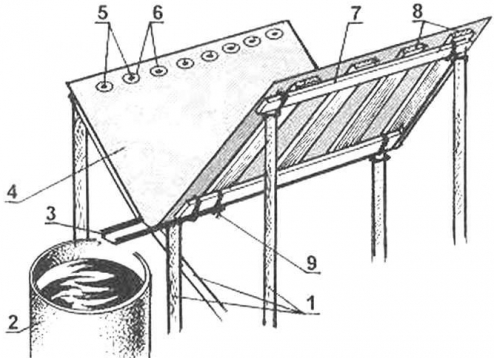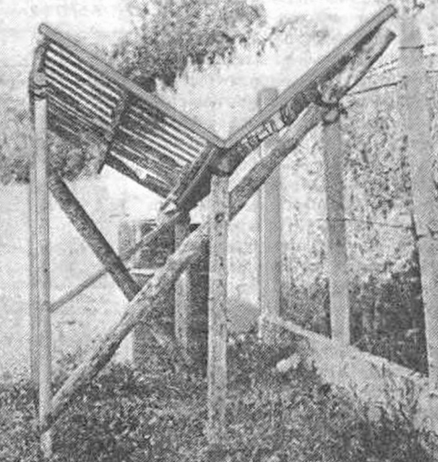 Free technical library
Free technical library
Rain water collection. Tips for the home master

Directory / Builder, home master
 Comments on the article
Comments on the article
On a newly developed suburban area, where the problem of water supply has not yet been solved, and even on some country garden or garden plots, there are constant difficulties with watering existing plantings: water has to be carried or transported from common columns, wells or reservoirs.
Especially a lot of such troubles in the dry seasons. However, even in such periods, no, no, but the long-awaited rain will fall. But you just need to wait for it not passively, but fully armed: prepare just such a simple trap for rain jets, as shown here, so that not one of them that does not fall on the plants is wasted, but ends up in any storage tank, retaining precious moisture in reserve.
The rain trap depicted in the figures is so simple in design that it is available for construction with its own sips in just one day, but it can last more than one season. It will not require either a specially allocated area for it or any scarce materials: in any corner of the site or somewhere near the fence, collected from what turned out to be, as they say, at hand. Therefore, its dimensions will be dictated by the place allocated for it. Structurally, the entire structure consists of a support base supporting it, a winged frame-batten and a film laid on top of it, used for greenhouses and hotbeds.
Base
It can be anything, since its only purpose is to support the main water collector so that it is higher than the storage tank and has a slope towards it. Therefore, even the fence itself could be a support on one side, if the structure is adjacent to it closely. Otherwise, poles or pipes dug into the ground will serve as the basis (without digging in, they will require reinforcing struts between themselves for stability).

Rainwater collector: 1 - supports (tests or pipes); 2 - storage container; 3 - gutter; 4 - coating (film); 5 - fasteners (nails); 6 - gasket (tin, linoleum); 7 - longitudinal element of the frame (block, rail); 8 - sheathing (wooden planks, picket fence); 9 - wire twists

Option for the supporting part of the water collector (using a fence)
The height of the base, as already mentioned, will depend on the storage capacity - on the one hand, and on the desired slope - on the other.
Frame
It consists of two wings converging at an angle of approximately 90 degrees. Each wing is collected from three longitudinal battens or wooden bars (boards), on which a crate of battens, planks or a picket fence left after the fence is stuffed. All parts of the frame are fastened together with nails, and the wings at the point of their joining are connected using wire twists.
Collector
As already mentioned, the film used for greenhouses can serve as a cloth for the water collector, but old linoleum, oilcloth and any other material that is not afraid of moisture will also come in handy.
Fastening the panel to the frame with nails, under the caps of which it is necessary to place gaskets made of tin or linoleum so that the wind does not tear the panel from the caps.
The assembly sequence of the panel with the frame is arbitrary. For example, for the convenience of work, even before the frame is installed on the supports, half of the water collector panel is nailed to one of its wings laid on the ground, and the second after the frame is assembled and mounted on the supports. In this case, it is convenient to fasten the remaining part of the panel from a stepladder.

Scheme of the fan version of the water collector: 1 - storage tank; 2 - double drain; 3 - arcuate water collector

Multi-tank Water Collector Kit
In the corner part of the water collector, from the side of the slope, any gutter-like drain is attached to the lower longitudinal parts of the frame on wire twists - for example. tin. The fastening of the gutter should allow its extension to be extended or shortened, if several storage tanks are used, in order to reach any of them
storage capacity
Of course, the most convenient and affordable container is any barrel (preferably plastic, as it is less susceptible to corrosion).
However, it can also be a small dug "well", the walls of which should be lined with a film so that the water accumulated from the rains does not go uselessly into the soil, but remains longer. For the same purpose, any container needs a lid, no matter what material: there will still be less evaporation.
Author: B.Revsky
 We recommend interesting articles Section Builder, home master:
We recommend interesting articles Section Builder, home master:
▪ Sauna in the garden
▪ Observation mini-pit in the garage
▪ Glass grip for carrying
 See other articles Section Builder, home master.
See other articles Section Builder, home master.
 Read and write useful comments on this article.
Read and write useful comments on this article.
<< Back
 Latest news of science and technology, new electronics:
Latest news of science and technology, new electronics:
Machine for thinning flowers in gardens
02.05.2024
In modern agriculture, technological progress is developing aimed at increasing the efficiency of plant care processes. The innovative Florix flower thinning machine was presented in Italy, designed to optimize the harvesting stage. This tool is equipped with mobile arms, allowing it to be easily adapted to the needs of the garden. The operator can adjust the speed of the thin wires by controlling them from the tractor cab using a joystick. This approach significantly increases the efficiency of the flower thinning process, providing the possibility of individual adjustment to the specific conditions of the garden, as well as the variety and type of fruit grown in it. After testing the Florix machine for two years on various types of fruit, the results were very encouraging. Farmers such as Filiberto Montanari, who has used a Florix machine for several years, have reported a significant reduction in the time and labor required to thin flowers.
... >>
Advanced Infrared Microscope
02.05.2024
Microscopes play an important role in scientific research, allowing scientists to delve into structures and processes invisible to the eye. However, various microscopy methods have their limitations, and among them was the limitation of resolution when using the infrared range. But the latest achievements of Japanese researchers from the University of Tokyo open up new prospects for studying the microworld. Scientists from the University of Tokyo have unveiled a new microscope that will revolutionize the capabilities of infrared microscopy. This advanced instrument allows you to see the internal structures of living bacteria with amazing clarity on the nanometer scale. Typically, mid-infrared microscopes are limited by low resolution, but the latest development from Japanese researchers overcomes these limitations. According to scientists, the developed microscope allows creating images with a resolution of up to 120 nanometers, which is 30 times higher than the resolution of traditional microscopes. ... >>
Air trap for insects
01.05.2024
Agriculture is one of the key sectors of the economy, and pest control is an integral part of this process. A team of scientists from the Indian Council of Agricultural Research-Central Potato Research Institute (ICAR-CPRI), Shimla, has come up with an innovative solution to this problem - a wind-powered insect air trap. This device addresses the shortcomings of traditional pest control methods by providing real-time insect population data. The trap is powered entirely by wind energy, making it an environmentally friendly solution that requires no power. Its unique design allows monitoring of both harmful and beneficial insects, providing a complete overview of the population in any agricultural area. “By assessing target pests at the right time, we can take necessary measures to control both pests and diseases,” says Kapil ... >>
 Random news from the Archive Random news from the Archive Gold floats in liquid air
02.01.2006
A group of physicists from the University of Nottingham (England) discovered a new physical effect: substances immersed in a vessel with liquid oxygen placed in a strong magnetic field float up in liquids, whatever their density. The heaviest metal will also float - osmium, which sinks even in mercury.
The buoyancy force depends on the density of the material and its magnetic properties, so objects are located at different levels in a tube with liquid gas.
The effect can be used in industry, for example, for separating diamonds and other minerals from the host rock, for sorting parts from materials of different densities. But in practice, liquid oxygen is better replaced by liquid air, which is cheaper and less flammable.
|
 Other interesting news:
Other interesting news:
▪ Wood is stronger than steel
▪ Women find it harder to quit drugs
▪ Gut bacteria affect people's brains and moods
▪ Plants behind the Great Wall of China
▪ satellite doctor
 News feed of science and technology, new electronics
News feed of science and technology, new electronics
 Interesting materials of the Free Technical Library:
Interesting materials of the Free Technical Library:
▪ section of the site Spy stuff. Article selection
▪ article by Samuel Taylor Coleridge. Famous aphorisms
▪ article What is the length of the longest trolleybus route in the world and where does it pass? Detailed answer
▪ article Slinger. Job description
▪ article Simple automatic lighting controls. Encyclopedia of radio electronics and electrical engineering
▪ article How to get additional voltages from a bridge rectifier. Encyclopedia of radio electronics and electrical engineering
 Leave your comment on this article:
Leave your comment on this article:
 All languages of this page
All languages of this page
Home page | Library | Articles | Website map | Site Reviews

www.diagram.com.ua
2000-2024







 Arabic
Arabic Bengali
Bengali Chinese
Chinese English
English French
French German
German Hebrew
Hebrew Hindi
Hindi Italian
Italian Japanese
Japanese Korean
Korean Malay
Malay Polish
Polish Portuguese
Portuguese Spanish
Spanish Turkish
Turkish Ukrainian
Ukrainian Vietnamese
Vietnamese





 See other articles Section
See other articles Section 